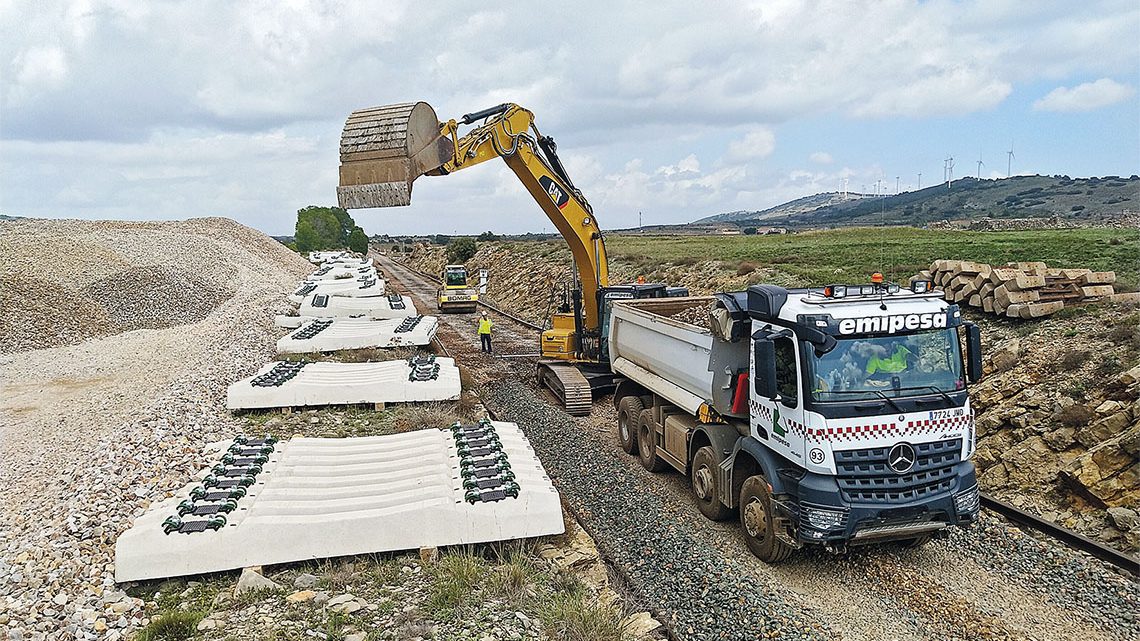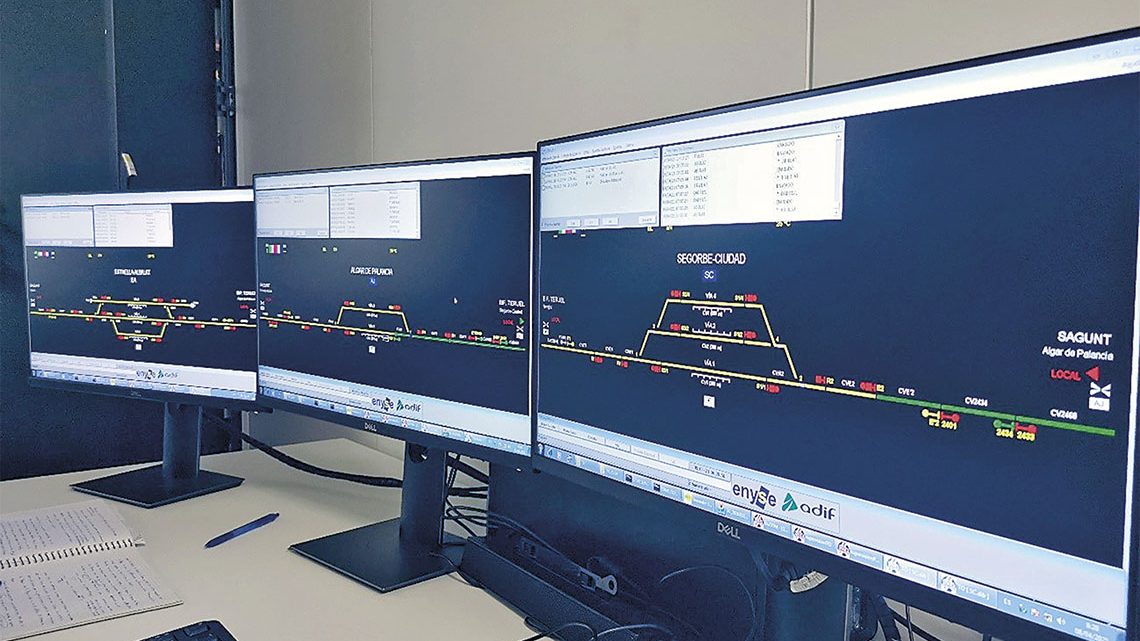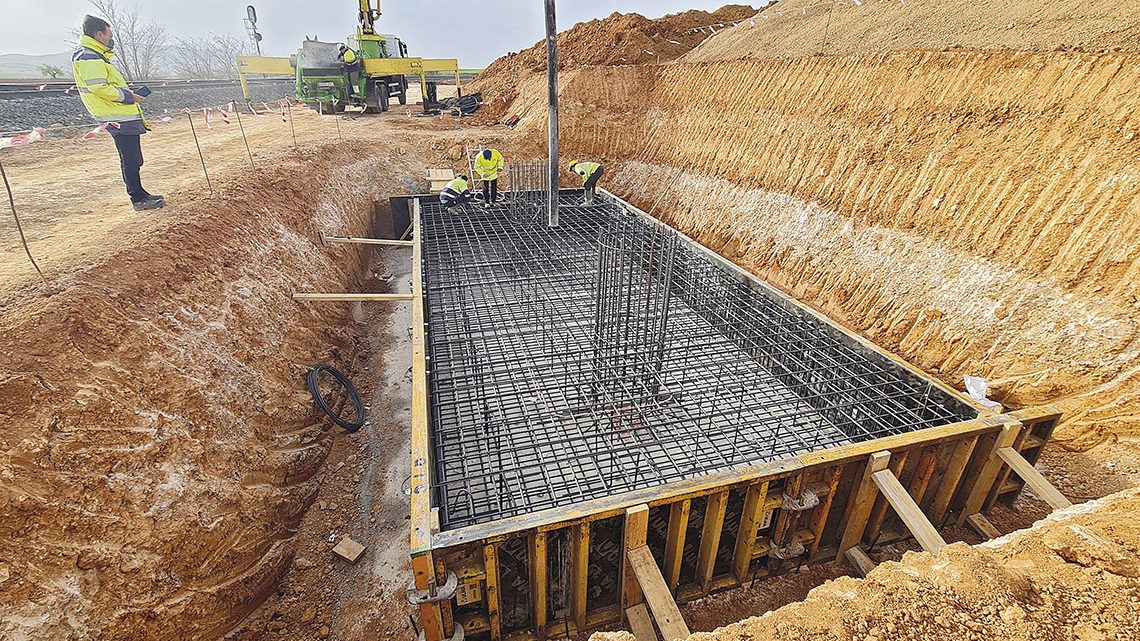The Cantabrian-Mediterranean Corridor comprises a set of railway infrastructures that will link the main ports on the Cantabrian and Mediterranean seas to the interior of the Iberian Peninsula, thereby serving as the backbone for a region that accounts for more than 21% of Spain’s GDP. The corridor falls within the scope of the funding mechanisms for the two major European corridors that pass through Spain, the Mediterranean and Atlantic corridors, and are intended to provide an effective interconnection with these corridors for both passengers and freight.
To achieve this, since 2017 work has been carried out to improve and modernise the Zaragoza-Teruel-Sagunto railway line (also referred to as line 610 under the nomenclature of Adif, Spain’s railway infrastructure administrator). Ineco has played an active role in these works since the beginning, with responsibility for drawing up plans as well as providing technical assistance and construction management. Working on behalf of Adif, between 2014 and 2017 Ineco produced a large number of studies and preliminary reports prior to the works commencing, in order to analyse the condition of the infrastructure and determine the actions required.
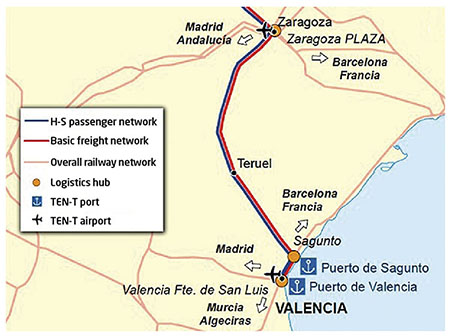
ACTION AREA. The main aim is to adapt the line to accommodate 750-metre trains. To achieve this, the track infrastructure and superstructure is being renovated, with new sleepers, rails, ballast, track devices and safety installations, while 750-metre sidings are being constructed in seven stations.
The ongoing improvements primarily consist of adapting the line –which was built in the late 19th century– to enable the circulation of standard European-length freight trains (750 metres), which is necessary for the line to form part of the network of Trans-European corridors; renovating all of the platform and track, the safety and communications installations, the stations and other structures (bridges, overpasses, underpasses, drainage systems, etc.); and electrifying the line.
Although the work will continue until 2025, the first stages are complete and have already begun to bear fruit in the form of increased traffic, especially freight; numbers have risen from three trains per week in 2016 to 30 per week. The main freight services, which are operated by five railway companies, include the transportation of vehicles and refrigerators from Valencia to Zaragoza and containers from Valencia to Júndiz Terminal in Vitoria and the port of Bilbao.
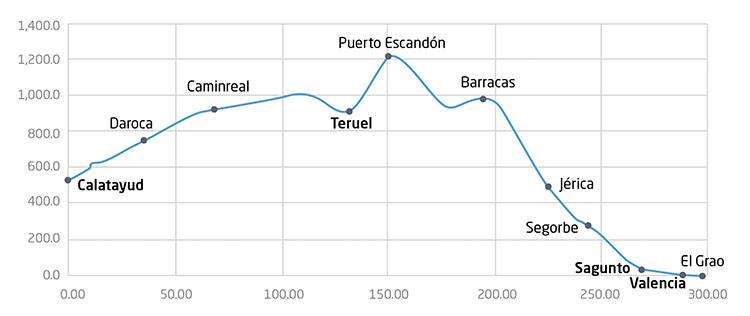
PROFILE OF THE CALATAYUD-VALENCIA LINE.
Completed works
The 190-kilometre Zaragoza-Teruel section has been renovated in recent years through a series of projects promoted by Adif and the ministry of Transport, Mobility and the Urban Agenda (MITMA). Works carried out between 2017 and 2019 include improvements and repairs to five embankments and the reinforcement of 11 structures to increase their axle load to 22.5 tonnes (as required by 750-metre trains); and the installation of a train-to-ground system between Sagunto and Teruel, which has made it possible to increase capacity by providing train paths around the clock, thereby improving traffic management and reducing journey time.
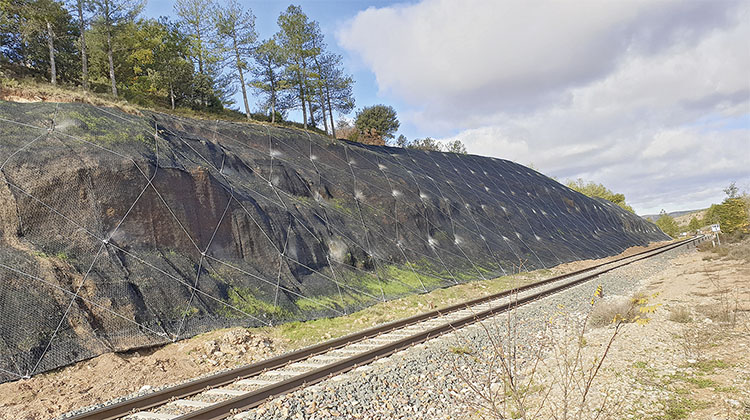
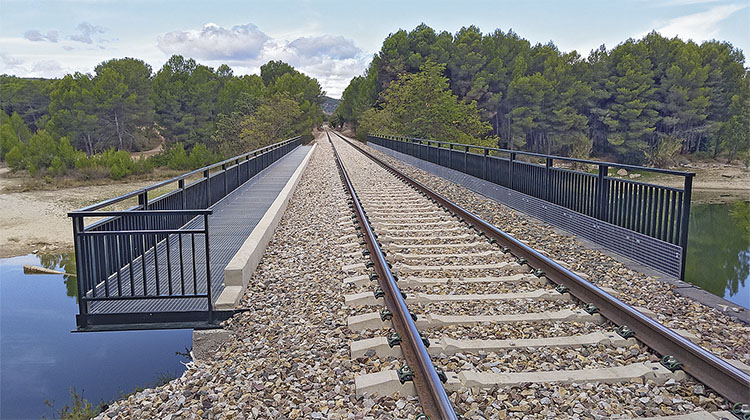
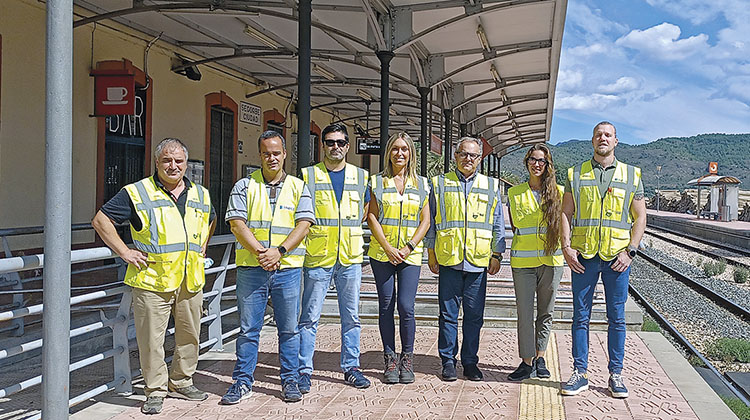
Ongoing works
The 137-kilometre Teruel-Sagunto section presents the greatest technical difficulty, owing to its steep and irregular relief. In addition to the work already completed, Ineco is currently overseeing the adaptation of the line so that it can accommodate 750-metre trains, in accordance with the construction plans drawn up by the company in 2018. To achieve this, the track infrastructure and superstructure is being renovated, with new sleepers, rails, ballast, track devices and safety installations, while 750-metre sidings are being constructed in seven stations. These activities have been divided into two separate projects: one focusing on Barracas, Navajas (a stop that will be converted into a station), Estivella, Puebla de Valverde and Teruel; and another focusing on the stations of Ferreruela de Huerva and Cariñena. The sidings are expected to be ready in 2021 and enter into service in 2022.
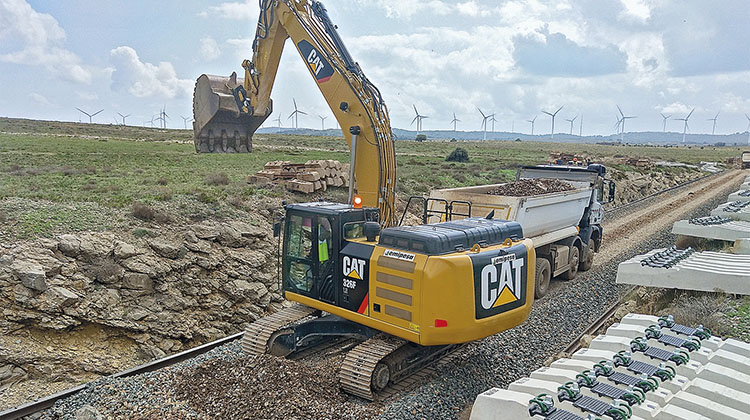
RENOVATION OF THE PLATFORM AND TRACK. 171,500 RS PR01 multi-purpose monoblock sleepers have been replaced in order to enable the switch to international gauge where necessary. Their added weight also helps maintain the gauge more effectively. Additionally, 16,200 metres of worn rail have been replaced with UIC 54 rail; various parts of the track have been cleared and a number of geometric defects corrected; the ballast shoulder has been enlarged where required and especially in curved sections, in order to ensure the transverse stability of the track. In total, 39,000 m3 of siliceous ballast has been used.
Additionally, Ineco is contributing to the design and management of the safety and telecommunications installations for both projects. Activities include the conversion of the automatic block signalling system, thereby increasing the line’s capacity and safety levels; replacement of the signalling control points on the Sagunto-Caudiel section; and installation of digital ASFA balises. The cable network will be prepared for the forthcoming 25kV electrification of the line, and the control centres in Zaragoza and Valencia will be updated.
A number of structural works –some 193 throughout the section– are also ongoing. The most significant include the replacement of railway slabs in 76 structures with two reinforced concrete half-slabs prefabricated in situ, with side paths on both sides; the installation of side paths in 142 structures; the installation of 182 guardrails and ballast-retainer walls in 96 structures; the repairing of significant damage where required; and construction of an underpass at km 133+558.
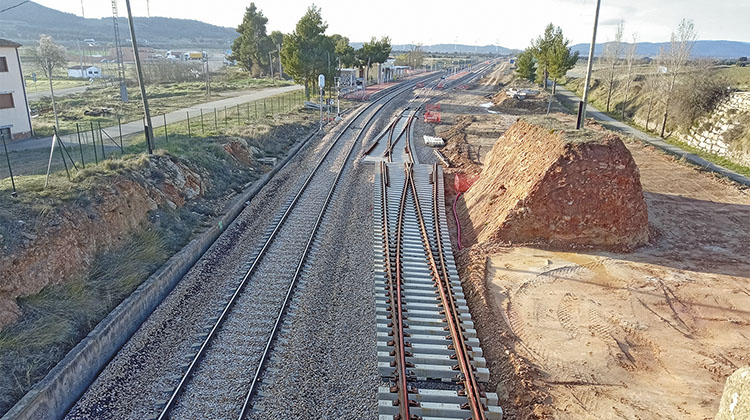
EXTENSION OF BARRACAS STATION TO 750 METRES. This station has a single, general-purpose track and two parking tracks, both downward. In terms of planned works, the two existing turnouts will be taken up, between the general-purpose track and track 3, and replaced with new equipment: namely, two turnouts at the threshold in Teruel and a crossover at the entry to Sagunto. Track 3 on the Sagunto side will be extended, with activities including the renovation and assembly of the new track and the construction of 40-metre shunting necks at either end. The elevated gradient of the general-purpose track will need to be adapted in line with track 3, meaning it will also be necessary to overlay the trackbed.
Other ongoing work to improve the safety of the line and extend its useful life includes the development of solutions for problems related to embankment settlements, drainage, and slippage that has been detected in certain cuttings. Some of these embankments required complex measures; for example, the embankment at Navarrete del Río, whose proximity to the River Pancrudo necessitated reinforcement with piles.
The electrification of the 25kV line is the next major milestone, with completion expected in 2025. Currently, plans are being drawn up and contracts awarded for the construction of the new substations and associated autotransformer stations; the remote power control system and high-voltage line in the areas of Cariñena and Villafranca; and the electrification of the Zaragoza-Teruel section. Soon, bids will be invited for the adaptation of the signalling installations throughout the entire section following its electrification, while the environmental surveys, studies and other procedures for the Teruel-Sagunto section are currently being carried out.
One of the main challenges for electrification is to make sure the existing 19 tunnels and 148 overpasses have the necessary clearance for the installation of the new overhead line. Ineco has already spent two years drawing up plans for the work.
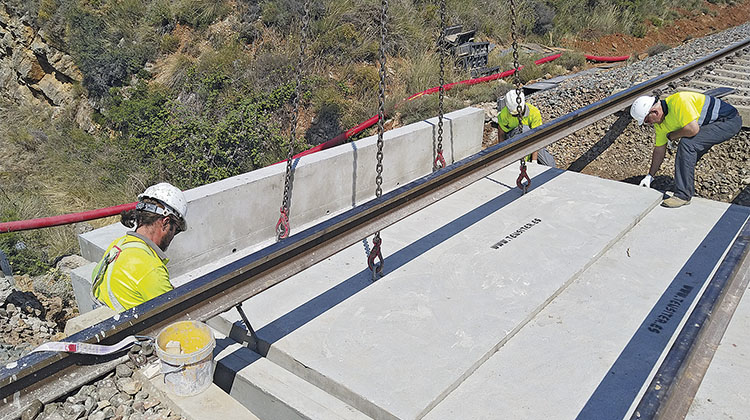
REPLACEMENT OF RAILWAY SLABS. The line currently incorporates numerous structures with a clear span of approximately 3.00 m. The deck for these structures consists of railway slabs with abutments and masonry wingwalls/supporting walls, whose width varies from 5.20 m to 5.45 m. These slabs will be replaced with two reinforced concrete half-slabs prefabricated in situ next to the structure or in the factory.
Other activities
The completed and ongoing activities have resulted in the creation of synergies between administrations. The government of Aragon is to build a freight terminal for 750-metre trains at Teruel Logistics Platform (PLATEA), with a branch line to the station at Cella (which will also be adapted in line with the construction plan drawn up by Ineco). The port of Valencia is also contributing to this investment.
In addition to the aforementioned works, Ineco is also carrying out a range of planning activities, developing and updating the informative studies for the line with a view to improving its performance. Provisional approval has been given to the informative study of the line between Teruel and Zaragoza; for the purposes of analysis, the study divides the line into 10 sections and proposes the construction of a bypass for three of them and track duplication for the rest. Effectively, the study proposes the creation of an electrified, high-performance double track capable of linking Zaragoza to Teruel in one hour and 10 minutes.
Ineco has also been awarded the contract for the informative study of the line between Teruel and Sagunto, in order to assess how it can be made compatible with the Mediterranean Corridor (part of the European Union’s TEN-T basic network).
Key data
- Sections: Zaragoza-Caminreal (Teruel) and Caminreal-Sagunto. The current route formed part of the old line connecting Calatayud to Caminreal and Sagunto, in Valencia. The Caminreal-Calatayud section was closed to traffic in 1985 and the track dismantled in 2011. At present, Caminreal station is being converted into a railway museum.
- Construction date: 1898-1902.
- Total length: 315.9 kilometres of non-electrified single track.
- Stations: 39 stations and stops.
- Maximum speed: 160 km/h between Zaragoza and Teruel (increasing to 200 km/h after electrification is completed) and 80 km/h between Teruel and Sagunto, owing to the steep gradients and extremely tight bends.
- Track profile: very sinuous. 80% of bends have a radius of less than 550 m, and some have a radius of 400 m, 300 m or even less. There are also pronounced elevation changes: the track starts in Teruel at an altitude of 878 m, ascends to 1,220 m at Puerto Escandón and terminates in Sagunto at sea level. In order to reduce the gradient, the track currently follows a very long route that is some 40% longer than the straight-line distance between Teruel and Sagunto. As a result, the average speed for this section is limited to 80 km/h. Even so, there are still ascending and descending gradients in excess of 21 thousandths.
A brief history of the Central Aragon Railway
The General Railway Plan, drawn up in 1864, included two projects that would make up the future Central Aragon Railway: the Calatayud-Teruel section, designed in 1869; and the Teruel-Sagunto section, designed in 1879. The franchise for the entire Calatayud-Valencia line was put out to tender on 15 November 1888, with exemption from all duties and a subsidy of 17 million pesetas; however, the bidding process failed. In 1894 it was put out to tender again, this time with a total subsidy of 25 million pesetas, and finally on 22 April 1895 the franchise was awarded to the sole bidder: namely, the Belgian Société Genéralé pour favoriser l’industrie National, which set up a company in Spain and would later end up transferring the franchise to the Central Aragon Railway Company.
As was common throughout the 19th century, the technical implementation was overseen by foreign (in this instance, Belgian) engineers and experts. In August 1895, work began at both ends of the line simultaneously. The first train arrived in Segorbe in 1898, followed by the opening of the Jérica-Barracas section in 1899 and the Puerto Escandón-Calatayud section in 1901. Lastly, the Valencia-Sagunto section was opened in February 1902, followed by the Valencia-El Grao section in September. By 31 December 1902 the construction of the entire line was complete.
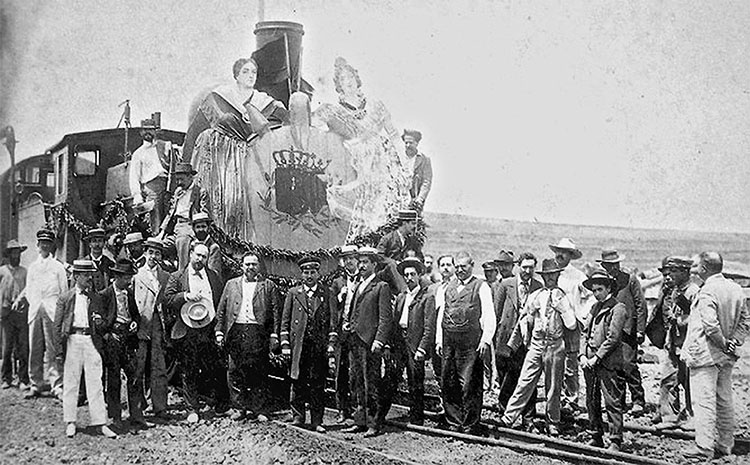
Opening of the Sagunto-Teruel line on 1 July 1901. / PHOTO_ORAW RAFF
Owing to the exemption from duties, the parent company of the construction firm decided to import all of the metal parts for the superstructure from Belgium. The very best and latest machinery was used, along with rolling stock that was not only one of a kind in Spain, but in Europe as a whole. It was the only railway line in the Iberian Peninsula whose structure incorporated metal sleepers with a trapezoidal cross-section and inverted box shape, onto which the rails were laid directly. The rails were nine metres long and weighed 31 kg, which gave them a longer life and greater ability to withstand the region’s climatic conditions. This system made it possible to use the fast, powerful Mallet and Garrat-type locomotives (unique in Spain and Europe, respectively) to climb the steep slopes of Puerto Escandón while distributing the load in order to avoid deforming the rails. The company was also a pioneer in the use of carriages with a metal chassis, which were safer in the event of an accident, and the use of first-class carriages alongside sleeper carriages, which were the most luxurious not only in Spain, but in Europe as a whole.
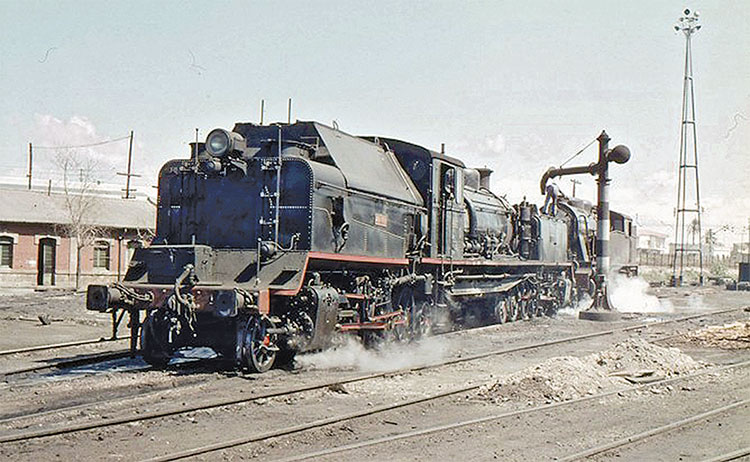
Central Aragon Railway Garrat-type locomotive. / PHOTO_XAVIER SANTAMARÍA
The points were also mounted on metal sleepers and imported from Belgium as a complete set, with all of their parts dismantled and ready for assembly in situ. The safety and communications installations were typical for the period: signalling between stations was carried out via telegraph, using a wire strung between poles placed parallel to the track. Ahead of the stations there were signs to warn the trains of the forthcoming stop, and the pointsman would wait for the train at the entry points with his flag unfurled. When the siding at Masamagrell was constructed, a central lever frame was introduced with remote activation via a funicular transmission system, which was later replicated in Caparrates and Masadas Blancas.
Sources: History of the Central Aragon Railway, Carlos Sanz Aguilera (Cámaras Aragón); History of the Railway in the Counties of Valencia: El Camp de Morvedre, Inmaculada Aguilar Civera (ministry of Infrastructure, government of Valencia); The Mine Railway of the Sierra Menera, Javier Aranguren (Aldaba ediciones); A Brief History of Steam Locomotion in Central Aragon, Pere Comas (AFB).


